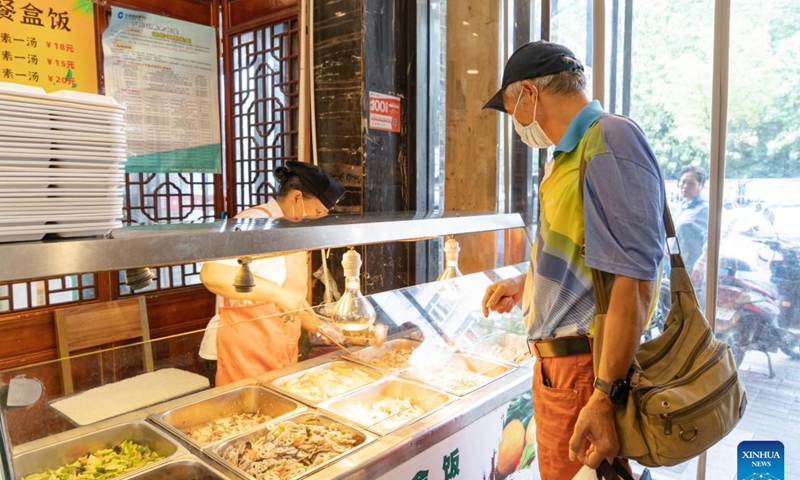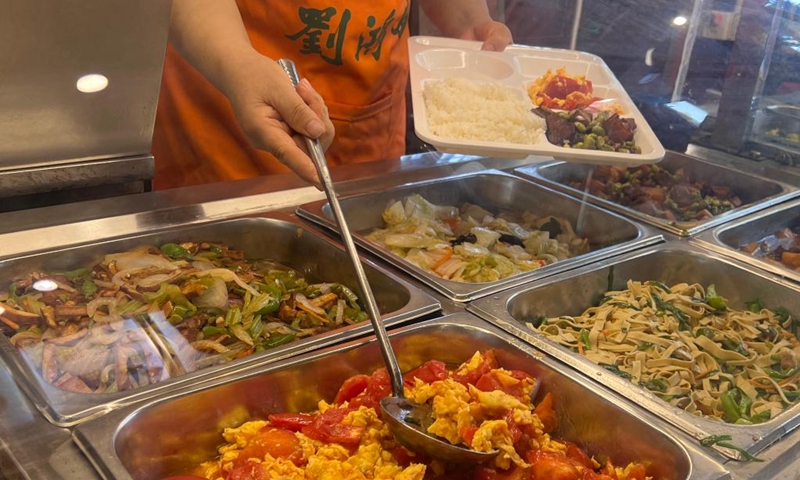
An elderly man chooses dishes at a counter inside a community canteen in Luyang District of Hefei, capital of east China's Anhui Province, Sept. 29, 2022. Photo: Xinhua

A staff member serves meals for senior citizens inside a community canteen in Luyang District of Hefei, capital of east China's Anhui Province, Sept. 29, 2022. Photo: Xinhua
Almost every weekday, Shi Xiangmei, a 79-year-old resident in Hefei, capital of east China's Anhui Province, would take a five-minute stroll to a canteen that caters exclusively to the elderly and enjoy her lunch there.
This special canteen, which is less than 150 square meters, is located in the Yicang Community. Shi usually orders a set meal with one meat dish, two vegetable dishes, as well as rice and soup, costing 9 yuan (about 1.3 U.S. dollars).
"There are many dishes on the menu, and the salt and oil content is relatively low, which perfectly fits our taste. And the price is cheaper than elsewhere," said Shi, adding that the special canteen has offered senior citizens in nearby communities convenient services, sparing them the trouble of cooking at home.
To meet the rigid needs of the elderly for their daily meals, such canteens have mushroomed in many places across the country. Anhui Province alone has a total of 4,892 canteens exclusively for the elderly, serving more than 4 million meals to older people.
Established in 2016, the canteen in Yicang Community is among the very first canteens in a pilot program launched by the city of Hefei. The initiative is supported by government subsidies and government-enterprise cooperation. The elderly can obtain a meal card after registering with the local community using their ID cards.
"Apart from extra food orders, we usually prepare 12 vegetable dishes and six meat dishes for each meal. For special groups such as centenarians and those living on subsistence allowances, the price of each meal can be reduced to 3 yuan," said Sun Jinfang, in charge of operations of the canteen.
The canteen is popular among the aged and it now receives more than 200 senior citizens every day, Sun added.
Earlier this year, the canteen launched a smart service system that enables the elderly to make facial-recognition payments, allowing them to enjoy the benefits of China's flourishing digital technologies.
Liu Qingchun, an official with the civil affairs bureau of Hefei's Luyang District, said the elderly meal service has been carried out in the entire district, and 65 local communities and seven villages will be fully covered this year.
"We are trying to create a '10-minute dining circle' for the elderly, offering them satisfactory meals at the doorstep," Liu said.
Ou Xiaoli, an official with the National Development and Reform Commission, said that in the next five years, China will strive to launch dining services exclusively for the elderly in over 80 percent of the communities in big cities.
In addition to cities, rural areas are also providing meal assistance services for the elderly.
At mealtime, senior citizens in Fushan Village in Anhui's Jingde County always congregate at the senior citizens' canteen.
After renovating the old kitchen and dining room of the village's elderly care service center, the canteen was officially inaugurated on April 25 this year and has provided more than 1,000 meals for the elderly.
Zhang Zongliang, a 69-year-old local villager from Fushan, frequents the canteen. "It's very close to my home. I walk 50 to 60 meters every day to get there. Each meal has at least two meat dishes, two vegetable dishes and a bowl of soup. It's worth spending 6 yuan for such a meal," Zhang said.
For older people with limited mobility, the village has also set up a volunteer team of five people to provide meal delivery services to those in need.
At present, there are 14 elderly canteens in the rural areas of the county. With just one smart card, a senior citizen can enjoy meals at any of these canteens, said Luo Yang, who works with the civil affairs bureau of Jingde County.
"We hope that by the end of 2025, a comprehensive elderly meal service network covering urban and rural areas, with a balanced layout, convenience and accessibility, can be built," Luo said.
